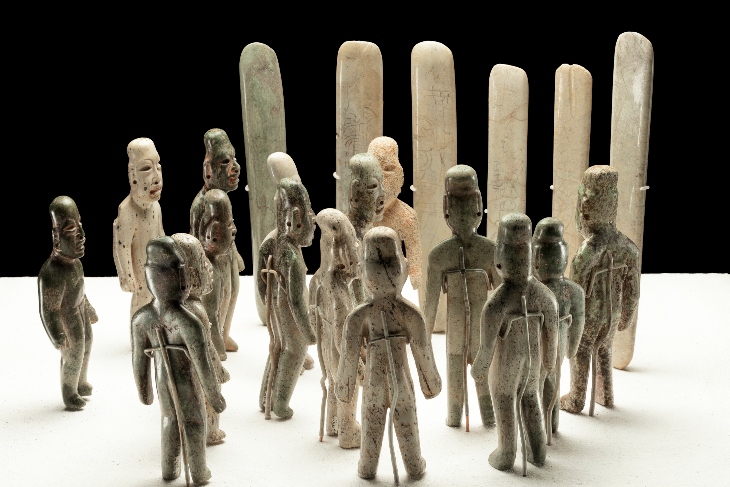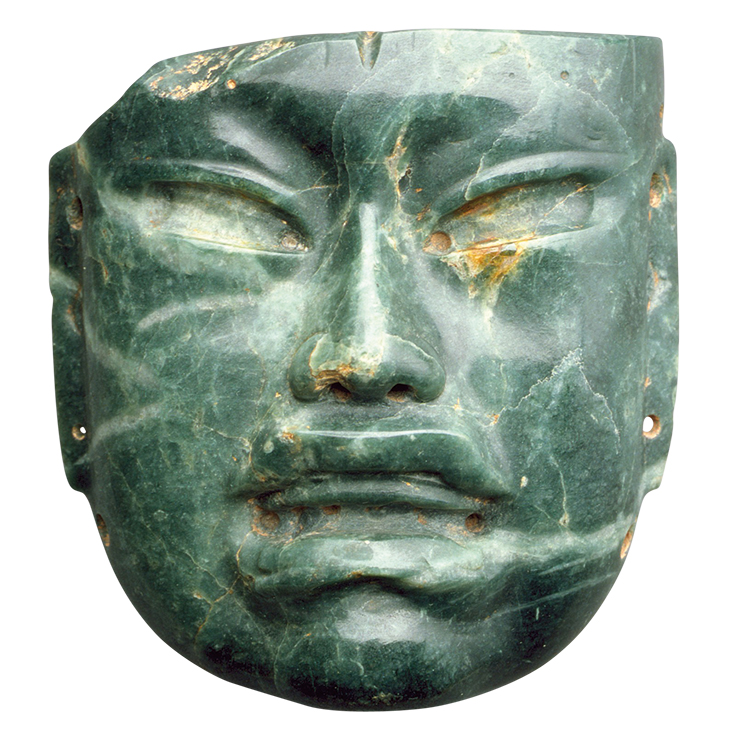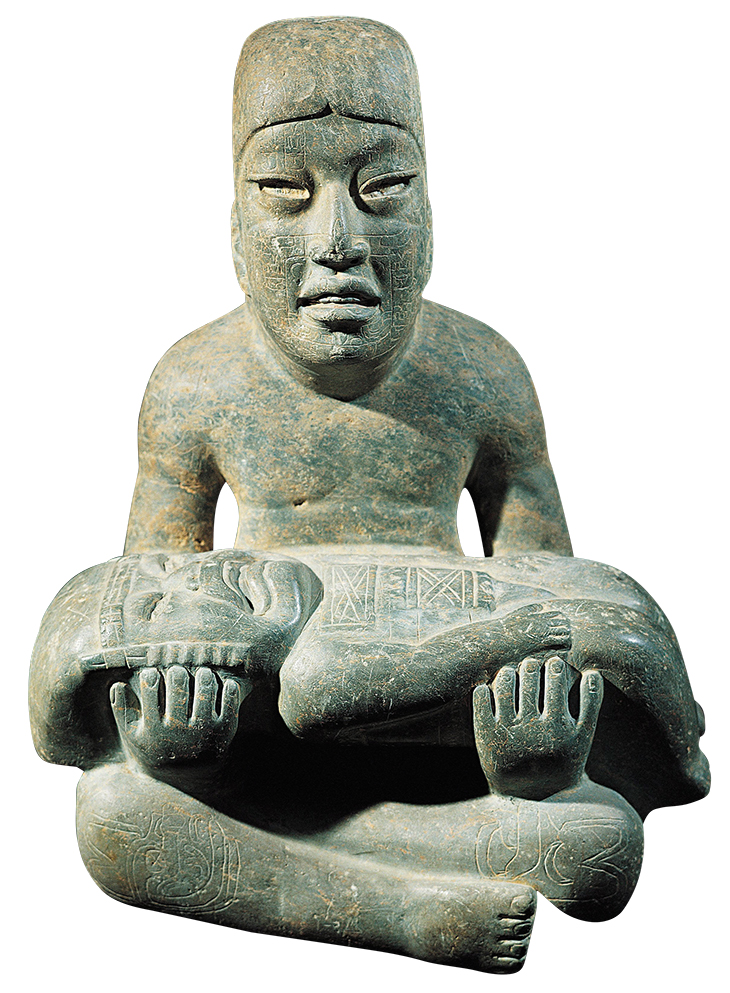Long overshadowed by traditions that loom larger in the public imagination such as the Maya and the Aztecs, artists of the Gulf Coast region of Mexico produced some of the most striking sculptures known from the ancient Americas. It was here that the first truly monumental stone sculptures were produced in the Americas – the so-called colossal heads of around 1200 BC – and it was here that Hernán Cortés and his men first made landfall in 1519 in the territory that is now the modern nation of Mexico. The dominant culture of this region between 1600 BC and 100 AD is generally designated as Olmec, and it exerted a lasting influence over its successor states. This area was home to some of the earliest urban centres and public architecture and towards the latter part of the Olmec period it was where distinctive writing systems were developed. Over time, however, writing (at least on monuments) became less important in the Gulf Coast region than in other parts of Mexico and Central America, particularly the Maya region to the south and east. This, in turn, may have contributed to the diminished presence of this region in our vision of Mesoamerica.
The Gulf Coast’s robust public sculptural tradition begins on a startlingly grand scale with the colossal heads, a tradition for which there is no clear antecedent. Carved from basalt primarily found in the Tuxtla mountains, some 100km distant, the giant boulders were likely transported to sites such as San Lorenzo and La Venta, two of the major Olmec sites, by raft. The fleshy folds of the faces, which are striking for their naturalistic visages suggesting portraiture, emerge beneath the tight helmets worn by warriors and ball-game players. Some of the heads are now known to have been recarved from altar-like thrones: what were once horizontally oriented blocks on which a ruler would sit were tilted upright on their sides and transformed into towering presences. A number of the heads – ten were found at San Lorenzo, including one as recently as 1994, four from La Venta, and several others elsewhere – were also intentionally defaced by grinding divots into the surface of the sculptures, for reasons still not fully understood either chronologically or in intention. The heads were likely originally lined up at the centres of sites, an outsize statement of power to any who ventured near the sacred precincts.
Colossal heads and other Olmec sculptures had been found as early as the second half of the 19th century, and the occasional studies of these monuments and sites ascribed them to the same period as the Classic Maya (250–900 AD) or even later. Matthew Stirling of the Smithsonian Institution began intensive excavations at Olmec sites in the 1930s, but in this era before radiocarbon dating, and in the absence of a Long Count date – the Mesoamerican system for recording fixed time – the chronological placement of the site relative to the Maya was uncertain. At the site of Tres Zapotes, however, Stirling uncovered a monument now known as Stela C, bearing a Long Count date correlating to 32 BC. The resulting inescapable chronological primacy of the Olmecs was hotly contested, most especially by the Mayanists, but ultimately Stirling – along with the artist Miguel Covarrubias and anthropologist Alfonso Caso, also great believers in the idea of the Olmecs as a ‘mother culture’ predating the Classic Maya – was proven correct. One might say the battle is not over, however, as recent discoveries at Maya sites such as Aguada Fénix are complicating the story by pushing back dates for the development of monumental architecture to 1000 BC, long before, in other words, a previously imagined Maya presence.
Seated figure (1200–900 BC), Olmec, Mexico. Metropolitan Museum of Art, New York.

The geographic extent of the Olmec phenomenon has also been the subject of intense debate in recent decades. Olmec-style works, particularly ceramics, have been found far beyond what is often called the Olmec ‘heartland’ of the Gulf Coast, including the state of Guerrero, in west Mexico, and Puebla, in the central highlands. Finely worked hollow ceramic figures, known as ‘babies’ for their infant-like characteristics, reveal the skill of early potters, if not precise iconographic meanings. The figures’ chubby bodies lack overt indications of gender, although some wear elaborate headgear similar to that depicted on the colossal heads. The white-slipped figures were often anointed with red pigment prior to burial. Olmec heads have made appearances with some frequency at US museums, and occasionally at corporate headquarters, such as the appearance of the 25-ton San Lorenzo Monument 1 installed on the plaza of the Seagram building on Park Avenue in New York in 1965. Major exhibitions dedicated to Olmec art and archaeology have been less frequent, however, and the most recent one, ‘Olmec: Colossal Masterworks of Ancient Mexico’, mounted at the Los Angeles County Museum of Art and the De Young Museum in San Francisco, was nearly a decade ago. But much new research has been conducted in recent years, and many important new finds have come to light, which makes ‘The Olmecs and the Cultures of the Gulf of Mexico’, an exhibition due to open this autumn at the Musée du Quai Branly in Paris and the first dedicated to the Olmecs in Europe, all the more welcome.
The Paris exhibition is an outgrowth of last year’s very successful ‘Golfo, Mosaico Ancestral’, organised by Rebecca González Lauck, a noted archaeologist with the Instituto Nacional de Antropología e Historia in Tabasco, and a curator at the Museo Nacional de Antropología in Mexico City, where the exhibition was first shown. González Lauck and her team gathered some 350 works from more than 40 different archaeological sites, many recently excavated and others rarely seen by the public. The objects, ranging from monumental basalt sculptures to small-scale jadeite figurines, were discovered in Veracruz and the neighbouring states of Tamaulipas, San Luis Potosí, Querétaro, and Tabasco – regions far from familiar to international tourists. Both the Mexico City and Paris shows – the latter organised by González Lauck with Steve Bourget, an archaeologist and curator at the Musée du Quai Branly – situate the Olmecs within a broader chronological sweep to include neighbouring and successor groups of the Gulf Coast and convey the sophisticated visual traditions of the region.
Offering 4 (900–400 BC), Olmec, Mexico. Museo Nacional de Antropología, Mexico City. Photo: © DeAgostino Picture Library/Scala, Florence

The monumental colossal heads – hard to miss – have always garnered the greatest public attention, but objects at the other end of the scale spectrum are equally intriguing. Excavations in 1955 at La Venta, in Tabasco, near the border with Veracruz, revealed numerous buried offerings, some containing small-scale figurines. The most famous, Offering 4, featured 16 male figurines between 16–20cm high – arranged as if in a scene, with six celts resembling stelae framing the action. The figurines were made of jadeite and other stones, some imported, and some clearly repurposed. The Olmecs were the first to exploit jadeite in the Americas, obtaining it from the Motagua River valley of what is today Guatemala, and laboriously sawing and grinding the hard stone into exquisite ornaments and sculptures. Jadeite was highly prized for its rich green colour, closely associated with maize and sustenance, but also more broadly linked to ideas of preciousness and enduring life.
The Olmecs also sculpted wood, although far fewer examples have survived to the present day. The largest cache of wood sculptures – 37 – was discovered in the late 1980s at the site of El Manatí, a spring at the foot of a hill south-west of La Venta on the Veracruz side of the border with Tabasco. Preserved in the anaerobic conditions of a bog, the busts, which date to c. 1200 BC, were part of a series of offerings that included jadeite celts and rubber balls – the world’s earliest. We do not know what the Olmecs called themselves but the name we use now is Nahuatl (the language of the Aztecs) for ‘the rubber people’, reminding us of the likely importance of this material in the Olmec economy, as well as the centrality of the ballgame itself in ancient Mexican life and thought.
Mask (900–400 BC), Olmec, Mexico. Metropolitan Museum of Art, New York

The La Venta figurines and the busts from El Manatí feature characteristic Olmec elongated heads with open, downturned mouths often revealing a toothless alveolar ridge, elements that have been a subject of much speculation but little consensus since these works came to broader public attention in the second half of the 20th century. The anthropologist Karl Taube and others have made notable strides linking specific details on the sculptures with certain deities. Taube has identified the cleft on the upper forehead of some jadeite masks, such as one in the collections of the Metropolitan Museum of Art in New York, as a representation of the earth from which maize plants sprout, connecting these works with the maize god and underscoring the close relationship between jadeite and concepts of fertility. Such masks were not intended to be worn by the living, or at least not over the face as the eyes and mouth were once likely inlaid with shell or obsidian. Perforations along the perimeter of the mask, however, would have allowed the work to be suspended as a large pendant or belt ornament, or attached to a funerary bundle.
This mask, as well as other Olmec greenstone works such as the Las Limas monument, so named for the site in Veracruz where it was found, has lightly incised imagery on the surface, likely visible only to those who had the privilege of seeing the work up close. The incisions on the cheeks of the mask are nearly worn off, but the Las Limas monument, a seated figure with another, smaller figure in its lap, bears four supernatural faces with cleft heads on its shoulders and legs as well as incisions on the face. At 55cm in height, the Las Limas monument is the largest known Olmec greenstone sculpture, and it is a startling work on many levels. It was originally found by schoolchildren, and the sculpture – so redolent in some respects of a Christian Madonna and child – was set up on an altar as the Virgin of Las Limas, though the seated figure is not clearly gendered. The limp figure in the lap, however, is far from the Western tradition: the ‘child’ sprouts a cleft head and the otherworldly features of an Olmec supernatural figure.
Las Limas monument (900–400 BC), Olmec, Mexico. Museo de Antropología de Xalapa. Photo: DeAgostino Picture Library/Scala, Florence

The Las Limas monument and many other works in ‘The Olmecs and the Cultures of the Gulf of Mexico’ are now cared for by the Museo de Antropología de Xalapa, also known as the MAX, of the Universidad Veracruzana. Designed by Paul Balev when he was with the architectural firm EDSA, founded by Edward Durell Stone Jr, the building of 1986 is an airy pavilion housing a remarkable collection of nearly 2,000 years of sculpture from the Gulf Coast region. The best place to see the colossal heads (the museum holds half a dozen), the museum also exhibits intriguing sculptures created after the Olmec period, including those from the Huasteca region in the northern Gulf Coast made in the Late Postclassic period (1200–1521 AD). Life-size figures represent men and women wearing luxurious regalia, including elaborate fan-shaped and fearsome anthropomorphic headdresses. Ultimately conquered by the Aztecs and incorporated into their rapidly expanding empire, the Huastecs with their towering sculptures form a powerful coda to one of the ancient world’s great sculptural traditions.
‘The Olmecs and the Cultures of the Gulf of Mexico’ is at the Musée du Quai Branly-Jacques Chirac, Paris until 25 July 2021.
From the July/August 2020 issue of Apollo. Preview and subscribe here.


